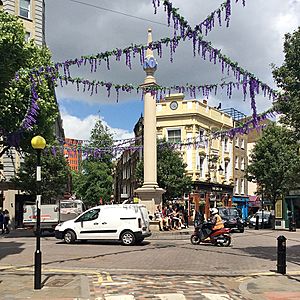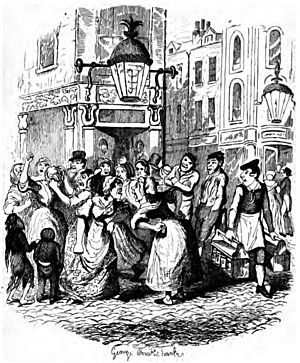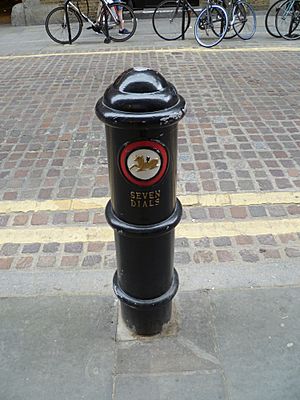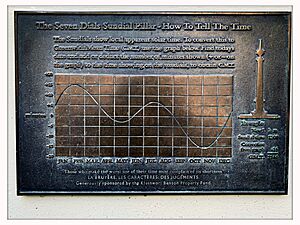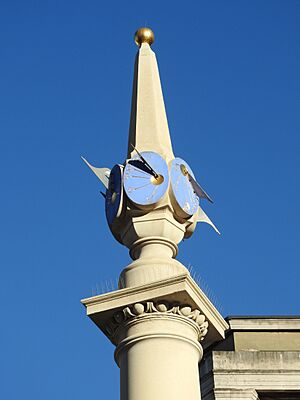Seven Dials, London facts for kids
Seven Dials is a special road junction and neighbourhood in the St Giles area of London. It's part of the bigger Covent Garden area in the West End of London. Seven streets meet at a round central area. In the middle, there's a tall column with six sundials. The column itself acts as the seventh sundial!
The Seven Dials Trust looks after the column and sundials. They also work with local groups to keep the area nice.
The Seven Dials area still has its original street plan from the 1600s. Many of the old Stuart houses are still there, even though they were updated later.
A special plaque nearby helps visitors tell the time quite well.
Contents
History of Seven Dials
Long ago, in the Middle Ages, an old hospital owned this area. King Henry VIII later took it in 1537. In the 1600s, a group of merchants called the Worshipful Company of Mercers owned some land here. They allowed buildings to be put up to earn money, as London was growing fast.
The original plan for Seven Dials was made by Thomas Neale in the early 1690s. His first idea was for six roads to meet, but this was changed to seven. The sundial column was built with six faces, and the column itself was the seventh sundial. This design created triangle-shaped plots of land. This was done to make the houses have smaller fronts, because rent was charged based on how wide a house was, not how big it was inside.
After the nearby Covent Garden Piazza became popular, Neale hoped Seven Dials would attract rich people. But this didn't happen, and the area became less fancy over time. At one point, each of the seven buildings facing the column had a pub. By the 1800s, Seven Dials was known as a very crowded and poor part of London.
Charles Dickens wrote about the area in 1835. He said it had "streets and courts [that] dart in all directions." He also noted that a visitor would find enough to "keep his curiosity awake for no inconsiderable time."
The poet John Keats also wrote about the area, describing it as a place for those who were poor and sick.
The writer W. S. Gilbert mentioned the area in his operetta Iolanthe, showing its low status:
Hearts just as pure and fair
May beat in Belgrave Square
As in the lowly air of Seven Dials.
Even in the early 1900s, Seven Dials was still a symbol of city poverty. Agatha Christie even set her mystery novel The Seven Dials Mystery (1929) there.
The first sundial column was taken down in 1773. People used to think an angry crowd pulled it down. But new research suggests it was removed on purpose by officials to improve the area. The pieces were bought by an architect named James Paine. Later, in 1820, people bought the pieces back and put them up again in nearby Weybridge. It became a memorial to Princess Frederica Charlotte of Prussia. The old, worn-out sundial stone is now next to Weybridge Library.
In the 1840s, Seven Dials was a big meeting place for the Chartists. They were a group fighting for changes in how people voted. However, some of their secret plans were stopped by the new police force.
By 1851, sewers were built in the area. But poverty continued in St Giles and Seven Dials. The number of people living there started to go down as workshops and breweries moved into some houses. A special plan by Margaret Frere was started here to help poor children get an education. This idea was then used all over London for school social work.
The seven streets at Seven Dials had different names long ago. They were Great Earl Street, Little Earl Street, Great White Lion Street, Little White Lion Street, Great St Andrew's Street, Little St Andrew's Street, and Queen Street. In the 1930s, their names were changed. Great and Little Earl Streets became Earlham Street. Great and Little White Lion Streets became part of Mercer Street. Great and Little St Andrew's Streets became Monmouth Street. And Queen Street became Shorts Gardens.
Today, only two houses from Thomas Neale's original 1690s plan are still standing: 61 Monmouth Street and 64 Neal Street.
Seven Dials Today
According to Camden Council, the Seven Dials area is north-west of Covent Garden Market and south of Shaftesbury Avenue. It includes Earlham Street, Monmouth Street, Mercer Street, and Shorts Gardens. The area also includes Neal Street and Neals Yard. Monmouth Street is the only street in Seven Dials with an official road number, the B404. The others don't have numbers.
In 1974, Seven Dials was named a special "Conservation Area." This means it's protected because of its history. By 1984, a committee helped make sure all empty homes were used. They also encouraged businesses to move into the area. Many buildings have been fixed up over the years. Since 1974, over 25% of the buildings in the area have been listed as historic.
Today, Seven Dials is a busy and successful neighbourhood. It's mostly filled with shops and businesses. It's located in the WC2 postcode area, between the West End theatre district and the popular shopping area around Neal's Yard. The narrow streets often have slow-moving traffic and lots of people.
The new sundial pillar was built in 1988–89. It was made to look just like the original design. Queen Beatrix of the Netherlands officially revealed it in June 1989. This was to celebrate 300 years since William III and Mary II ruled, which was when the area was first developed. The Seven Dials Trust owns and takes care of the monument. They also work to make the area better.
In 1994, Sir Alan Bates started the Tristan Bates Theatre. It's a small fringe theatre with 100 seats, located on Tower Street. Alan Bates and his son Benedick named it after Tristan, Alan's other son, who passed away in 1990. The theatre has since been updated and is now called the Seven Dials Playhouse.
By late 2017, a company called Shaftesbury plc owned many of the buildings in the area. Big changes were happening, like turning a shopping mall into a single large store. An old warehouse was also being changed into office space.
One of the seven corners still has a pub called The Crown. Another corner has the Cambridge Theatre, and a third has the Radisson Edwardian Mercer Street Hotel. On another corner is the Comyn Ching Triangle, which is a group of old buildings that were fixed up in the 1980s. Even with some new developments, many original buildings are still there.
There are two historic plaques in the area. One is at 13 Monmouth Street, where Brian Epstein ran his company. The other is in Neal's Yard, at the old studios of Monty Python members Michael Palin and Terry Gilliam from 1976 to 1987.
A report from November 2017 described Seven Dials like this:
This group of streets has nearly 100 fashion, beauty, and lifestyle stores. It also has about 90 independent cafés, bars, and restaurants. You can find food, fashion, and music festivals all year. There are also big parades or private shopping events. And there's lots of culture, including many of the West End's best-known theatres nearby. ... Seven Dials mixes small, independent shops with big, well-known British brands. It has street food and fancy restaurants. It's modern and cool, but you can still feel its past in its cobbled streets and courtyards.
The Sundial Monument
Thomas Neale asked an architect and stonemason named Edward Pierce to design and build the sundial pillar in 1693–94. The original drawing is kept in the British Museum.
The monument has an eight-foot (2.4m) tall base. On top of that is a 20-foot (6.1m) tall column. The part with the six sundials and the very top is ten feet (3m) tall. This part has sundials facing directly north and south, and four others that face different directions. The monument was put up in 1694 but taken down in 1773.
The Seven Dials Trust started rebuilding a copy of the monument in 1985. It was put up in 1989. This was the first project of its kind in London since Nelson's Column was built in the 1840s. Caroline Webb designed, carved, and gilded the sundials. An astronomer named Gordon Taylor checked the math. Each sundial is very accurate, within ten seconds. The sundials show local apparent solar time. So, you need to use a special graph on the base to figure out the exact clock time. Seven Dials is a tiny bit west of Greenwich, which means it's about 3 seconds behind Greenwich Mean Time.
Seven Dials in Books and TV
- "The Monmouth Street Cap" is a poem from 1819 by Elizabeth Beverley. It's a funny story about public charity.
- One of the stories in Charles Dickens' book Sketches by Boz (1837–1839) is called "Seven Dials".
- In H. G. Wells' 1897 short story "The Crystal Egg", a shop near Seven Dials owns a special object.
- In Pio Baroja’s 1908 novel "La ciudad de la niebla", the main character lives near Seven Dials. It's described as a place that used to have a bad reputation but is now just a busy square.
- Agatha Christie's 1929 book, The Seven Dials Mystery, is set here. In 1981, a TV show was made from the book, starring famous actors like John Gielgud.
- C. S. Forester's novel Mr. Midshipman Hornblower (1950) has a duchess who speaks with a very common accent from Seven Dials.
- The police station in the British TV show The Gentle Touch (1980–1984) was named Seven Dials.
- "I could be a rambler from the Seven Dials" is the first line of Stephen Stills's 1991 song "Treetop Flyer".
- Some episodes of the 2008 British TV show City of Vice take place around Seven Dials.
- Slammerkin, a 2000 novel by Emma Donoghue, is partly set in Seven Dials.
- In Terry Pratchett's 2012 novel Dodger, Seven Dials is where much of the story happens and where the main character lives.
- The Bone Season, a 2013 novel by Samantha Shannon, is partly set in Seven Dials.
- Roddy Frame's 2014 album is called Seven Dials. He said in an interview that he spent a lot of time there.
- Brenda Hiatt's five-book Saint of Seven Dials series is about heroes who steal from the rich to help the poor in the Seven Dials area during the Regency era.
- The 23rd book (2003) in Anne Perry's historical series, featuring Charlotte & Thomas Pitt, is called Seven Dials. Part of the book takes place in this area.
- The last book in the Williamson Papers series, Back Home by Tom Williams, is also set in 19th-century London. A character gets into trouble in Seven Dials.
- In Robert Tressell's novel The Ragged-Trousered Philanthropists, the Liberal Party candidate's campaign uses tough guys from Seven Dials.
- Punjabi singer and rapper Sidhu Moose Wala filmed a music video in Seven Dials in May 2021.
Property Development
Most of Seven Dials is owned by Shaftesbury PLC. They also work with the Worshipful Company of Mercers on the nearby St Martin's Courtyard.


